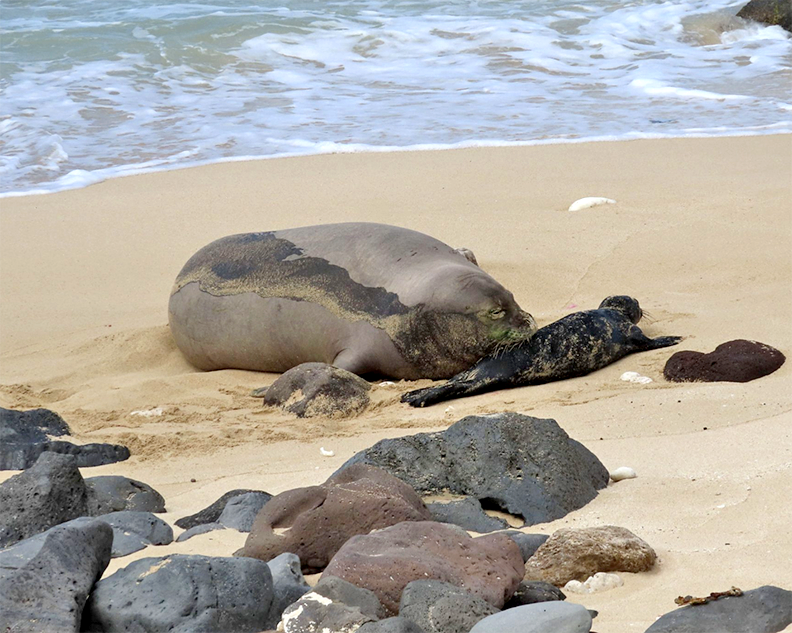By Léo Azambuja

The ‘akeke‘e is only found on Kaua‘i, and there are about 1,000 of them left. Photo by Robby Kohley
Long before Polynesians arrived in the Hawaiian Islands more than a 1,000 years ago, songbirds were already firmly established in coastal and upland forests. They painted the island with their brilliant colors and harmonious songs.
The only mammals in Hawai‘i were sea mammals — monk seals, dolphins and whales — and the hoary bat. Birds had no natural predators, and thrived and evolved here for hundreds of thousands of years.
Perhaps one of the most fascinating cases of adaptive evolution in the Islands is the Hawaiian honeycreeper, which evolved into at least 59 species. Most of them are bright-colored and sing melodic songs. They are significantly diverse, with many species having unique bill shapes for different purposes. Some eat only nectar, or fruits and seeds, while others eat insects and snails.
When the Polynesians arrived in Hawai‘i, they found a tropical paradise for all the species thriving here, isolated from the rest of the world. But for some of those species — especially the songbirds — this paradise would soon come to an end.
There were at least 113 species of endemic birds in Hawai‘i before any human set foot here. Between the Polynesian arrival and the first Europeans in Hawai‘i, at least 48 species of birds disappeared. Many of them were hunted for their plumage, which was used in feather capes and helmets made for Hawaiian royals and nobles, and high-ranking officials.
Polynesians also brought rats, which prey on nesting birds and their offspring.
Since 1778, when Capt. James Cook first landed on Kaua‘i, another 23 species of birds went extinct. Since European contact, cats, urbanization, habitat loss and mosquito borne diseases such as avian malaria and avian pox added to the mix.
I can only applaud the work of conservationists who are keeping the remaining birds from becoming extinct.
The ʻalalā, or Hawaiian crow, had already gone extinct in the wild many years ago. Today, there are less than 100 ʻalalā that have been introduced into Big Island’s forests, with a few more in captivity. It is technically the most endangered bird in Hawai‘i.
The kiwikiu, or Maui parrotbill, is right behind. Lisa “Cali” Crampton, program coordinator for the Kaua‘i Forest Bird Recovery Project, said that after conservationists translocated some kiwikiu to a habitat on Leeward Maui, almost all the birds succumbed to avian malaria. The number of mosquitoes there turned out to be much higher than suggested by any previous research. Researchers thought the number of kiwikiu was around 300, but it is much more likely to be between 100 and 150 birds, she said.
On Kaua‘i some of the most endangered birds are the puaiohi, the ‘akeke‘e and the ‘akikiki. All of them are only found on Kaua‘i, and are present in very small numbers. Both the ‘akikiki and puaiohi have about 500 or less individuals left, and the ‘akeke‘e about 1,000.
The puaiohi is also known as small Kaua‘i thrush, and is related to the extinct kama‘o, or small Kaua‘i thrush. The kama‘o was last seen in 1989, and declared extinct in 2004.
Despite having very small numbers, these three Kaua‘i birds have a shot of survival. Crampton is confident the birds are able to survive until their major threat, mosquito borne diseases, can be effectively controlled through the release of sterile males in the forest in a couple of years.
If we look at the ʻalalā’s recovery, and also the nēnē, or Hawaiian goose, Crampton’s confidence is backed by a solid precedent.
At one point, there were as few as 37 nēnē left, all of them on the Big Island. A long-standing captive breeding and release program was able to bring the nēnē back from the brink of extinction. Today, there are close to 3,000 nēnē across Hawai‘i.
If you want to hear and learn more about the colorful songwriters of Hawai‘i, check out the free Symphony of the Hawaiian Birds at Kaua‘i Community College Performing Arts Center on Feb. 23 at 4 p.m. Visit symphonyofthehawaiianbirds.com for more information on how to get your free tickets.
Discover more from ForKauaiOnline
Subscribe to get the latest posts sent to your email.




Leave a Reply